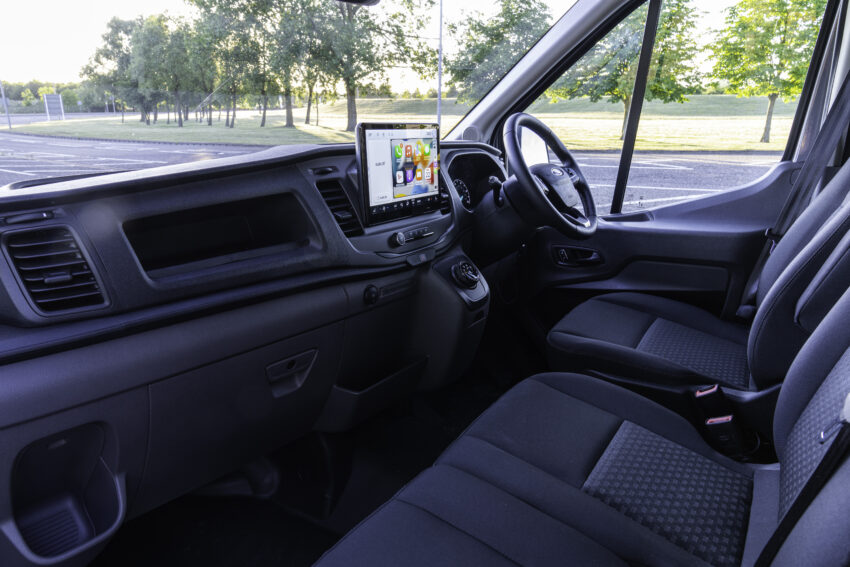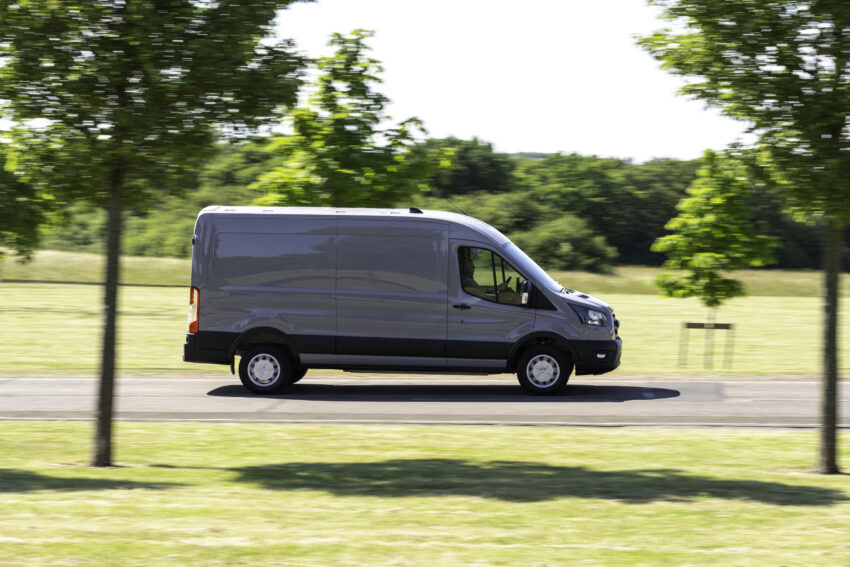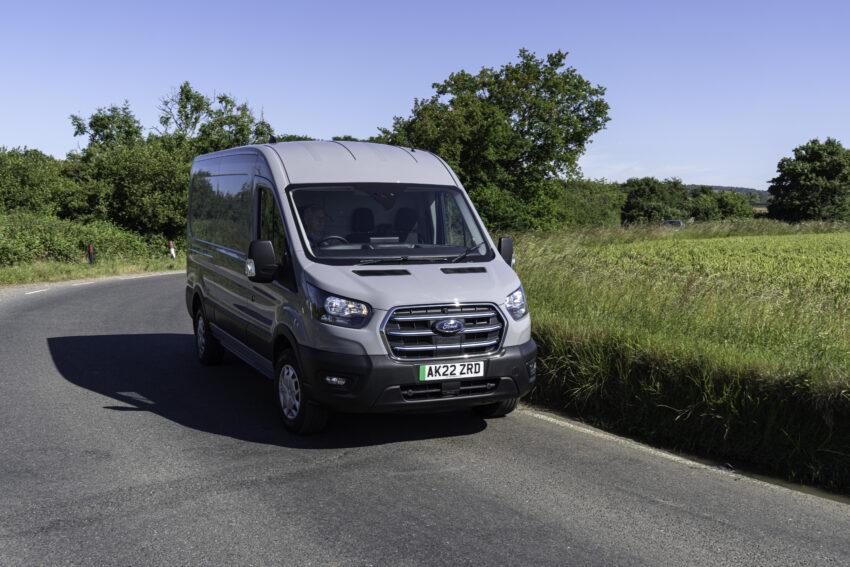Ford E-Transit review: Does Ford’s electric van still have Britain’s back?
We test the ‘Backbone of Britain’ to see if the Ford E-Transit is still the van to beat in the new world of electric LCVs
At first glance, the E-Transit looks almost identical to the regular Transit. Aside from some blue detailing, there’s precious little to indicate the presence of an electric motor and battery pack instead of a diesel engine.
Given the Transit’s significance — it’s the ‘backbone of Britain’, of course — it makes sense that Ford kept the styling familiar. However, substantial changes have been made beneath the surface.
Converting an existing vehicle to an EV is challenging, as seen with the early versions of the Citroen e-Relay and Peugeot e-Boxer. Ford has spent serious money on updating the underpinnings in the E-Transit, replacing the rear leaf springs with a new rear subframe and independent coil-sprung suspension, creating space for the electric motor on the rear axle.
The electric large van market is reinventing itself, with a revised Vauxhall Movano Electric (and its Citroen, Fiat and Peugeot twins), a new Toyota Proace Max on its way, Chinese rivalry from the Maxus eDeliver 9 and an updated Mercedes-Benz eSprinter. Despite the heavy investment, the Ford E-Transit won’t have an easy ride.
Design, interior and technology
As with the exterior, the E-Transit’s cabin closely resembles that of the regular diesel-powered model, although the gear lever and handbrake have been replaced by electric switches on the dashboard. This change creates more space in the cab, making it feel airier and, crucially, giving the middle passenger somewhere to put their legs.
A 12-inch infotainment screen dominates the dashboard, serving as the central hub for most functions. With Ford’s impressive Sync 4 software installed, the screen is crisp, clear, and responsive, although some functions are slightly hidden. It’s a shame that most climate controls are now on the screen instead of physical switches, but that’s indicative of the continuous march of technology.

Leader-spec vans are rather bare-bones models suited as fleet vehicles to be used and abused. Trend vans, as we had, are a little more refined, with smarter seats, climate control, and a few other toys. There are no high-spec Limited models in the E-Transit range or rugged Trail vans, which makes it clear where Ford sees its market.
Battery, motor and performance
The E-Transit has a 68kWh battery pack that powers a 181bhp electric motor, with a higher-power 266bhp version available. Both models produce 317lb ft of torque, crucial for carrying heavy loads, but don’t be too tempted by the higher-power option — unless you mash the throttle pedal to the floor, it operates with the same 181bhp limit, so there’s no difference in day-to-day driving.
While not huge, the battery is big enough to promise a WLTP range of 196 miles. Ford suggests a more realistic (and arguably worst-case) range of 100 miles under full load, motorway conditions, and winter temperatures. Even then, this should be sufficient for the average Transit user, who apparently drives about 59.5 miles each day.
We covered hundreds of miles in the north of the country, achieving 2.5 miles per kWh, which works out at about 170 miles from a full charge. That’s not great considering the van was empty, but we spent a lot of time hammering down various A roads and motorways around the Scottish Borders, which does nothing for efficiency.
When we needed to stop, recharging from 15% to 80% took just over half an hour at 115kW, which is enough time for a quick break at Greggs before getting back on the road.
An extended range option with an 89kWh battery pack improves range by another 53 miles, but at the expense of payload limits.
Ford’s modifications to the suspension have improved the Transit’s handling, comfort, and refinement, which wasn’t bad to start with. You might not be able to have much fun behind the wheel, but you certainly won’t be fatigued after a day on the UK’s roads.

Payload and practicality
Ford offers the E-Transit in 15 different configurations, including three body lengths, two roof heights, and three gross vehicle weights, so finding a suitable version for your business should be relatively easy. With no loss of space from the battery pack and motor, the cargo volume remains consistent with the diesel-powered Transit, which ranges from 9.5m³ to 15.1m³.
Although the payload capacity is slightly reduced due to the battery pack’s weight, it can still reach up to 1,785kg. At the other end of the range, there’s just 790kg to play with on the L4H3 models limited to a GVW of 3.5 tonnes.
Load lengths run from 3,083mm to 4,256mm, with the two roof heights offering internal clearance of 1,786mm or 2,025mm.
The mid-size L3H2 panel van with a 350GVW chassis, which we tested, had a payload limit of 980kg and a cargo volume of 11.0m³ thanks to its 3,533mm load length. Vans up to 4.25 tonnes GVW are available, which can be driven on a car licence under some circumstances, which adds 750kg of payload capacity to each model.
Price and specification
The Ford Transit price list runs to 72 pages, so consider this section a very brief and oversimplified view of the range. The entry point to E-Transit ownership is £49,545 plus VAT and other fees, but before any government grants. That gets you the 135kW model in Trend spec with an L2H2 body. If you want the vast L4H3 model with a 198kW motor in plusher Trend trim, you’ll need £57,235 plus VAT.
You’ve also got double-cab panel vans, chassis cab models, tippers, Luton vans with tail lifts, welfare vans, and dropside bodies to pick from, which is a comprehensive range nobody else can compete with.
If you want anything other than a regular panel van, it’s probably best to visit a Ford dealer and discuss the myriad options.

Verdict
It took Ford some time to bring the E-Transit to market, potentially giving the likes of the Vauxhall Movano Electric a head start, but what Ford turned up with blew the competition into the weeds.
Even now, two years later, it’s the class of the field — although the revised large vans from Stellantis look interesting. The compromises made to switch the Transit from diesel to electric power are so subtle that, unless you desperately need every kilogram of payload or every mile of range offered by ICE versions, you could find plenty of competitive advantages for putting the E-Transit on your fleet.
The asking price is steep compared to a diesel model, although it broadly matches its competitors. However, lower running costs and energy costs, Ford’s innovative Liive active monitoring, and very competitive finance deals mean the total cost of ownership could well swing in the eLCVs’ favour. With a Ford service centre on every corner and an industry dedicated to maintaining Ford’s finest, it’s incredibly easy to recommend.
Ford E-Transit Trend 135kW L3H2
- Price: £52,035 plus VAT and OTR
- Powertrain: rear-motor, rear-wheel-drive
- Battery: 68kWh
- Power: 1181bhp
- Torque: 317lb ft
- Top speed: 81mph
- 0-62mph: N/A
- Range: 196 miles
- Consumption: 2.9m/kWh
- Charging: up to 115kW






